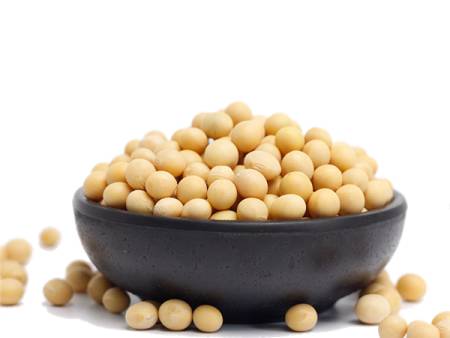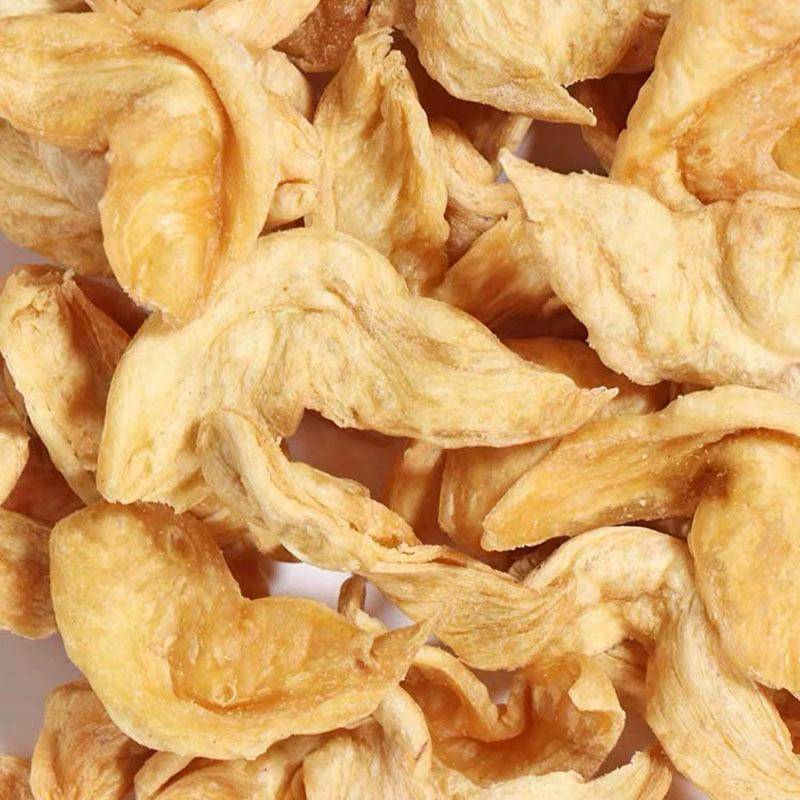Is Soy Protein Healthy?
Soybeans originated in China and are the king of beans. They have been cultivated and used in China for more than 4,000 years, and soybean cultivation is an important part of China's agriculture. Protein is the main component of soybeans, and the content varies from 30% to 50% depending on the variety [1]. Any processing of soybeans involves the processing of soy protein, so soybean processing can also be referred to as soybean protein processing. Soy protein is a complete plant-based protein that contains essential amino acids that the human body cannot synthesize. It is complete in variety, balanced in proportion, and abundant in content, with high levels of lysine and leucine, accounting for 6.0% to 6.9% and 7.4% to 8.4% respectively [1].

Soy protein is the preferred plant protein resource for replacing animal protein. It can effectively prevent cholesterol intake, reduce saturated fatty acid intake, lower blood lipids, improve insulin sensitivity, and reduce body fat. Since the 1980s, industrial production of soy protein has gradually been realized in China. Soybean meal, which is obtained after the degreasing of soybeans, is used as raw material. With the production technology and complete sets of equipment introduced from abroad, products such as isolated protein and concentrated protein are produced. Soy protein products have various functional properties such as emulsifying, gelling, foaming and antibacterial properties [2–4].
With people's growing needs for a better life and the rapid development of science and technology, China's food industry, especially the development of the soy protein processing industry, has reached a new level. However, there are still problems such as a single variety of soybeans, insufficient varieties of soybeans for specific uses, overcapacity of primary processing enterprises, serious homogenization of deep-processed varieties of soy protein, and a lack of high value-added and differentiated products [5–11].
This paper introduces the supply and demand of soybean protein raw materials, the scale of processing enterprises, and the product structure in China. It analyzes the problems that the soybean protein industry urgently needs to solve, and puts forward the development trend of the soybean protein industry, with a view to promoting the long-term high-quality development of China's soybean protein industry.
1 Current development status of China's soybean protein industry
1.1 Supply and demand
1.1.1 Supply of soybean raw materials
The processing volume of soybeans in China in 2022 is shown in Table 1. As can be seen from Table 1, the total processing volume of soybeans in China in 2022 will exceed 110 million tons, of which genetically modified soybeans will be 89.3888 million tons, accounting for 80.27%, and non-genetically modified soybeans will be 21.9722 million tons, accounting for 19.73%. 22 million tons, accounting for 19.73%. Genetically modified soybeans are mainly imported from Brazil and the United States, of which Brazil accounts for 60.86% and the United States accounts for 32.48%. Other countries that import genetically modified soybeans include Argentina and Uruguay. At the same time, China imports some non-genetically modified soybeans from the United States, Russia, Benin, Canada, Ukraine and other countries, of which Russia accounts for 41.00% of total imports, the United States accounts for 29.70%, Benin accounts for 12.40%, Canada accounts for 11.30%, and Ukraine accounts for 4.00%.
1.1.2 Soy protein industry chain
The uses of genetically modified soybeans and non-genetically modified soybeans are different, but both require physical, chemical, and microbial processing before being processed into feed, edible products, and other products [12-14]. As shown in Figure 1, soy protein can be divided into rough processing and deep processing. The rough processing of non-genetically modified soybeans includes high-temperature soybean meal, low-denatured soybean meal, soy products, and direct consumption. High-temperature soybean meal can be further processed into ordinary feed and fermented products, while low-denaturation soybean meal can be further processed into isolated protein, concentrated protein and textured protein, which are ultimately used to make plant-based foods. The crude processing of genetically modified soybeans includes high-temperature soybean meal and protein meal, which can be further processed into products such as feed and protein concentrates.
At present, non-genetically modified soybean protein products are mainly used for food processing and for human consumption; genetically modified soybean protein products are mainly used in the feed processing industry for livestock, poultry and aquaculture. Data from the China Feed Industry Association shows that soybean feed meal will reach 65.8 million tons and food meal 2.1 million tons by 2022. Soybean meal can be used directly as a feed ingredient or as a raw material for concentrated protein and fermented soybean meal. According to incomplete statistics from the China Feed Industry Association, in 2022, the output of fermented soybean meal produced by further processing feed meal as a raw material will be 700,000 tons, and the output of feed-grade concentrated protein will be 300,000 tons. Soybean meal is mainly used for processing isolated protein, concentrated protein, etc. Low-denatured soybean meal is used as a raw material for further processing products, mainly including isolated protein, alcohol-concentrated protein, acid-concentrated protein, modified concentrated protein, texturized protein, etc.
According to the data from qichacha.com,in 2022, the production of soy protein isolate will be the largest, at 500,000 tons, followed by textured soy protein at 300,000 tons, soy protein concentrate by alcohol process at 200,000 tons, modified soy protein concentrate at 50,000 tons, and soy protein concentrate by acid process at 30,000 tons.

1.1.3 Soy protein processing enterprises
The overall registration of soy protein processing companies in China is on the rise. According to the data from qichacha.com, by the end of 2021, there will be about 30,000 soy protein processing-related enterprises in China, with 39 low-temperature soybean meal production lines and a production capacity of 20,000 t/d. Among them, Shandong and Heilongjiang rank first and second in terms of the number and production capacity of low-temperature soybean meal production lines, accounting for more than 80% of the total number and production capacity of low-temperature soybean meal production lines in China. There are relatively few soy protein concentrate production lines in China.
As of the end of 2021, the situation of food-grade soy protein concentrate and feed-grade soy protein concentrate production enterprises in China (data from qiacha) is shown in Tables 2 and 3, respectively. As can be seen from Tables 2 and 3, the annual production capacity of food-grade soy protein concentrate in China reaches 250,000 tons, and the annual production capacity of feed-grade soy protein concentrate reaches 290,000 tons.
Among the food-grade soybean protein concentrate production lines, except for those of a company in Daqing, a company in Zhalantun, and a company in Keshan, the rest are all in normal production and sales; among the feed-grade soybean protein concentrate production lines, except for the one under construction by Tianjin Beihe, the rest are all in normal production and sales. Among them, Fujian Changde's 90,000 t/year feed-grade soybean protein concentrate production line is currently the largest production line in China. This production line adopts an energy-saving process that integrates two-step leaching and drying and evaporation.
The process route is green and energy-saving, water vapor consumption is 50% of similar advanced equipment in the world, reaching 800 kg/t (based on raw material quality). On July 15, 2019, the China Cereals and Oils Association organized well-known industry experts and professors to evaluate Shandong Kstar's “Development and Industrialization of Large-scale Intelligent Complete Equipment Technology for Alcohol-based Soy Protein Concentrate” project, forming the following evaluation opinions: The complete equipment technology developed by the project has independent intellectual property rights, and its economic and social benefits are and the overall technical level has reached the international leading level[15].
1.1.4 Market demand for soybean protein
The market size and growth rate of China's soybean protein industry from 2015 to 2019 are shown in Figure 2. As can be seen from Figure 2, China's soybean protein market has maintained steady growth in recent years, and the market size in 2019 has reached 12.752 billion yuan, a year-on-year increase of 2.3%. According to different processing techniques, soy protein deep processing products are mainly divided into concentrated protein, protein powder (also known as isolated protein), and textured protein (also known as drawn protein). Currently, the market is dominated by protein powder and textured protein. Protein powder accounts for about 1/3 of sales, while textured protein accounts for about 2/3.

Protein powder products have a protein content of about 90%, are cholesterol-free, and have an amino acid composition that is easily absorbed by the body. They are widely used as food additives or supplements, in soy-based formula milk powder, and as food supplements. [8]; textured protein products have a protein content of more than 55%, have good water and oil absorption, and are processed through mixing, extrusion, shearing, and other processes to form granular, block, strip, and other shapes with a muscle-like texture similar to animal protein.
The texture and appearance of these products are very realistic, and they can be used in the production of foods such as meatballs, sausages, vegetarian ham, and minced meat. These products combine the low cholesterol of soy protein with the good fibrous structure and chewiness of animal protein. They are a high-protein, low-fat food [9]. The replacement of animal protein with textured protein can reduce production costs, increase the content of soy protein in foods, and improve the dietary structure [16]. The demand for textured soy protein and soy protein powder in China from 2015 to 2019 is shown in Figure 3. As can be seen from Figure 3, in 2019, the demand for textured soy protein in China was 722,000 tons, and the demand for soy protein powder was 397,000 tons.
Soybean meal is a high-quality protein ingredient in animal feed. Due to many factors such as the breeding cycle of downstream farming, import quotas and the international environment, the quantity and price of soybean meal demand have fluctuated greatly, but the overall supply and demand is basically balanced. The output of industrial feed and soybean meal in China from 2016 to 2022 and their growth rates are shown in Figure 4. As can be seen from Figure 4, in 2022, China's industrial feed production will be 30,223.4 million tons, an increase of 3.0% over the previous year; and soybean meal production will reach 79.897 million tons, an increase of 4.0% over the previous year.
1.2 Problems
1.2.1 Supply and demand of soybean protein raw materials
China's annual soybean consumption exceeds 110 million tons. As the largest importer of soybeans, China relies on imports of genetically modified soybeans. In 2022, the highest domestic soybean production will be 20.28 million tons, but it still cannot meet the market demand for non-genetically modified soybeans, and a small amount of imports will be required.
Although China has a large area of land under soybean cultivation, there are still the following problems: firstly, there are few varieties of soybeans, and there is a lack of differentiated varieties that can meet the needs of different soybean protein products. For example, soybean protein products require varieties with a high concentration of 7S and 11S proteins and a low sugar content, while the processing of soy milk and soybean milk requires varieties with a low content of unsaturated fatty acids. However, the breeding of enterprises and scientific research institutions through biotechnology and genetic engineering is relatively lagging behind, and there have been no substantial major breakthroughs in large-scale experiments to cultivate ideal strains with different compositions and contents has not achieved substantial breakthroughs.
Second, there is a disconnect between soybean breeding technology and promotion in China. Breeding enterprises are relatively small, with weak independent innovation capabilities. They are mainly regional enterprises, and there are few large-scale leading enterprises. Third, processing enterprises and soybean planting bases cannot form an accurate traceability chain, which cannot effectively guarantee the source of soybean varieties. The wide and diverse scope of collection and storage increases post-processing costs and greatly reduces production efficiency. Therefore, it is necessary to improve independent innovation capabilities, fill in the gaps in the soybean seed industry, and establish a precise matching and integration mechanism for soybean raw material demand and production supply. This is of great significance for improving China's self-sufficiency in soybeans and ensuring the safety of edible protein supply.

1.2.2 Soy protein processing enterprises
Research on the technology related to deep processing of soybeans in China started relatively late, and most of it is still in the primary processing stage. According to the data from qichacha.com, there are currently about 30,000 soy protein processing related enterprises in China, of which 115 are primary processing enterprises with a scale of more than 1,000 t/d, with a production capacity of 440,000 t/d, which is already seriously excessive.
According to the data from qiachecha, by the end of 2022, there will be 26 soy protein isolate enterprises in China, with a capacity of 800,000 t/year and an operating rate of less than 100%. Soy protein isolate enterprises mainly use the alkaline solubilization and acid precipitation method to extract and separate protein. Each ton of protein produced consumes about 18 tons of water vapor and produces about 40 tons of whey wastewater[8]. Whey wastewater contains a large amount of organic matter[9] , and if it is directly discharged, it will cause great pollution and serious damage to the environment. It must be discharged after a series of complex treatments. Although effective sewage treatment processes have been developed to decompose and recycle whey wastewater, the combination of soybean protein isolate and sewage treatment processes has high energy consumption and production costs, resulting in high product prices and a lack of market competitiveness.
Although there are a large number of plant-based food companies whose main raw material is soy protein isolate, most of them are small factories and workshops that produce a single type of product, have excess capacity, and lack large leading enterprises that produce high value-added products.
1.2.3 Structure of the soybean protein product
At present, soybeans are mainly used for three purposes: extracting or pressing for cooking oil, whole or skimmed for livestock protein feed and food processing.
The imported soybeans in China are mainly used to produce soybean oil and soybean meal feed. The soybean meal feed is mainly made of ordinary soybean meal and concentrated protein as a protein additive. The fermentation of soybean meal for deep processing products is seriously restricted due to the high water vapor consumption (1-1.5 t/t), uneven fermentation, and large fluctuations in product quality.
Domestic soybeans in China are mainly used for the initial processing of soy products and for direct consumption. Deeply processed products account for a relatively small proportion. Plant-based foods with soy protein isolate as the main ingredient have a single product type and uneven quality due to the smell of soy and anti-nutritional factors, which in turn affects market expansion. At present, China's soy protein food industry has not yet broken through the production model that mainly focuses on traditional foods. There is still a large gap between China and developed countries in terms of variety, appearance and flavor. China's soy protein industry also has problems such as single products and low-price competition. There is a lack of market categories for high value-added products such as functional soy protein, biomimetic foods, fermented soybean meal, etc.
2. Development trends of China's soy protein industry
2.1. Soy protein raw materials
General Secretary Xi Jinping emphasized at the Central Rural Work Conference held on December 25–26, 2021, that ensuring the supply of primary products is a major strategic issue. The Chinese people's rice bowls must always be firmly in their own hands, and the rice bowls should mainly be filled with Chinese grain, so that the “oil bottles” are filled with more Chinese oil. During his inspection tour of Shandong in October 2021, he also emphasized that the production and sales areas of oilseed crops such as soybeans must stabilize acreage and increase production, thoroughly and effectively adjust and improve the structural distribution, and conduct in-depth research and development of breeding technologies for oilseed crops such as soybeans, in order to achieve significant production increases.
The 14th Five-Year Plan for the Development of the National Planting Industry proposes that by 2025, soybean production should strive to reach 23 million tons, an increase of 17.35% over 2020, and increase the self-sufficiency rate of soybeans. 35%, and increase the self-sufficiency rate of soybeans. The 2023 Central Document No. 1 clearly states: increase efforts to expand the planting of soybeans and oilseeds; further promote the project to increase the production capacity of soybeans and oilseeds; steadily promote the strip-cropping of soybeans and corn, support the rotation of grain and beans in the Northeast and Huanghuaihai regions, and steadily develop and utilize saline-alkali land for planting soybeans; improve subsidies for corn and soybean producers; clarify the soybean production target for 2023 and incorporate it into the provincial-level party committees and governments to implement the assessment of the same responsibilities of the Party and the government for cultivated land protection and food security.
Data released by the General Administration of Customs shows that in the past decade, except for a slight decrease in 2020, China's soybean imports have increased year by year, and China's non-genetically modified soybean production has also generally shown a year-on-year upward trend. The “Statistical Communiqué of the People's Republic of China on the 2022 National Economic and Social Development” released by the National Bureau of Statistics in 2023 stated that due to a series of favorable policies introduced by the national and local governments to promote soybean production, China's soybean production reached a record high of 20.28 million tons in 2022, an increase of 23.7%. It is expected that for a considerable period of time in the future, the production of domestically produced non-genetically modified soybeans will usher in a period of rapid growth.
2.2 Soy protein products
According to the recommendations of the Food and Agriculture Organization of the United Nations and the World Health Organization (FAO/WHO), the per capita intake of protein is 0.75 g/(kg·d). Soy protein is close to the pattern of essential amino acids required by the human body, does not contain cholesterol, and has abundant raw material sources, so it has broad development prospects. China is the world's largest market for soy protein, accounting for about 50% of the market. In recent years, people's dietary consumption has gradually prioritized safe nutrition and health value, which will directly promote the increased consumption of soy protein products.
The rise of plant-based foods is a reflection of people's pursuit of a simple lifestyle, a return to simple and healthy eating, and a dietary revolution. Some reports show that the world's largest meat processing company JBS (JBSAY), American food giants Tyson, Hormel, Smithfield Foods, etc., as well as international and domestic companies such as Jinluo, Shuangta, Bifei, Meikang, large chain restaurants such as Kentucky Fried Chicken, FamilyMart, and chain convenience stores, are all pushing plant-based foods.
Statistics from China Credit Information Service show that the demand for vegetarian food, a plant-based food product or ingredient made from textured soy protein, is expected to increase from 500,000 tons in 2015 to 900,000 tons in 2022, and to 1.2 million tons by 2026. As a high-quality raw material for plant-based food or feed, textured soy protein has the advantages of high gelation and emulsification, a complete range of amino acids and complete amino acid profile, very low content of anti-nutritional factors, no bean smell, etc. In addition, the production process is environmentally friendly and clean, with no wastewater discharge. Soy protein concentrates will gradually replace soy protein isolates and are becoming increasingly popular in the market.
Soy protein is widely used as a food ingredient in industries such as meat processing and plant protein drinks. It is not only healthy and safe, but also nutritious and satisfies consumers' pursuit of product taste. On the basis of soy isolate protein, soy concentrated protein and soy textured protein, new soy protein products such as active protein powder, peptide powder and gelatin protein are developed to broaden their application fields, so as to continuously meet consumer demand.
2.3 Soy protein processing enterprises
Primary soybean processing enterprises will develop towards large-scale, intensive, and coastal concentration. As the profits of primary processed products decrease and competition increases, the market will gradually eliminate small-scale, high-cost, and high-energy-consuming enterprises, and further optimize and improve the process routes and geographical distribution of large-scale enterprises.
As people's awareness of nutrition and health increases, concerns about the negative effects of antibiotics and other factors in animal foods, as well as concerns about environmental protection and sustainable ecological development, plant-based foods have attracted a great deal of attention. Plant-based food companies will develop in the direction of product diversification, complexity, and health and nutrition. As a raw material for plant-based foods, the soybean protein industry will also develop rapidly. Soya protein isolate enterprises are gradually being replaced by green, low-energy alcohol-based soya protein concentrate enterprises due to their high energy consumption and serious pollution. Alcohol-based soya protein concentrate enterprises have broad development potential.
3 Conclusion
As a processing industry for agricultural and sideline products, the soya protein industry can extend the industrial chain of local vegetable oil crops, add value during processing, help farmers increase their income, enrich the food on people's tables, and meet people's needs for a nutritious and healthy life. Its development has always been valued and strongly supported by the state. China is the world's largest producer and consumer of non-genetically modified soybeans, and non-genetically modified soy protein products are also popular worldwide.
At present, improving China's self-sufficiency in non-genetically modified soybeans and developing high value-added soy protein products have become urgent issues that need to be addressed in the soy protein industry. Alcohol-process soy protein concentrate products are favored by the market because of their high nutritional value, low content of anti-nutritional factors, and production process that is free of the smell of soybeans, low energy consumption, no wastewater discharge, environmentally friendly, and clean production. The growth of the soy deep processing industry will help to give domestic soybeans a competitive advantage, creating a situation of complementary competition with imported soybeans. China's soy protein industry will also achieve high-quality development.
References:
[1] He Dongping, Wang Xingguo, Liu Yulan. Manual of design for oil and fat plants [M]. 2nd edition. Wuhan: Hubei Science and Technology Publishing House, 2012: 387-389.
[2] Yang Qian, Feng Guangxin, Feng Weiting, et al. In vitro digestion characteristics of protein in common soybean products [J]. Food Science, 2022, 43(9): 39-47.
[3] Feng Wei. Effect of mild enzymatic hydrolysis of soybean protein on the storage quality of nutritional bars [J]. Fermentation Science and Technology Newsletter, 2021, 50(2): 75-81.
[4] Deng Wenya, Xu Jingting, Guo Shuntang, et al. Nutritional evaluation and comparison of hempseed protein and soybean protein [J]. Food Industry Science and Technology, 2021, 42(23): 273-279.
[5] Liu Di, Zhao Xiaoyan, Fu Lidan. Research progress of 7S and 11S globulins in soybean protein [J]. Food Research and Development, 2016, 39(17): 201-204.
[6] Lin Fengyan, Yi Xiaoli, Guo Xingfeng, et al. Development and industrialization of large-scale intelligent equipment technology for the preparation of soy protein concentrate by the alcohol process [J]. China Oil and Fat, 2020, 45(4): 28-31.
[7] Dong Ji, Lin Fengyan. Process for preparing soy protein concentrate by alcohol method [J]. China Oil and Fat, 2008, 33(6): 24-25.
[8] Shi Yanguo. Current situation and development suggestions of domestic soy protein isolate industry [J]. Food and Machinery, 2000(3): 25.
[9] Jin Xun. The development prospects of the soybean protein industry are broad. China Oil and Fat, 2006, 31(10): 81.
[10] Zheng Hengguang, Yang Xiaoquan, Tang Chuanhe, et al. The processing technology and practice of alcohol-based soybean protein concentrate. China Oil and Fat, 2007, 32(4): 26-28.
[11] CHAJUSS D. Soy protein concentrate: processing, properties and prospects [J]. Inform, 2001(12): 1176-1180.
[12] WANG S Y, FEI Y M. Application of vegetable textured protein in red sausage [J]. Soybean Science and Technology, 2011(4): 54-55.
[13] Sun Yuemei, Hao Xiaoliang, Jiang Lianzhou, et al. Development of vegetarian meatballs made from soy tissue protein [J]. Soybean Bulletin, 2007(2): 23-25.
[14] Wang Di, Chi Yujie. Optimization of the formula for soy tissue protein meatballs [J]. Food Industry Science and Technology, 2011(9): 110-115.
[15] Wang Ruiyuan. Innovate to seize the commanding heights of the development and utilization of soy protein [J]. China Oils and Fats, 2021, 46(3): 1-2.
[16] Yang Wen. Study on the effect of additives on the physical and chemical properties and structure of organized wheat protein [D]. Hefei: Hefei University of Technology, 2017.
-
Prev
What Is the Use of Hydrolyzed Soy Protein in the Food Field?
-
Next
What Is the Property of Soy Protein Powder?


 English
English French
French Spanish
Spanish Russian
Russian Korean
Korean Japanese
Japanese




